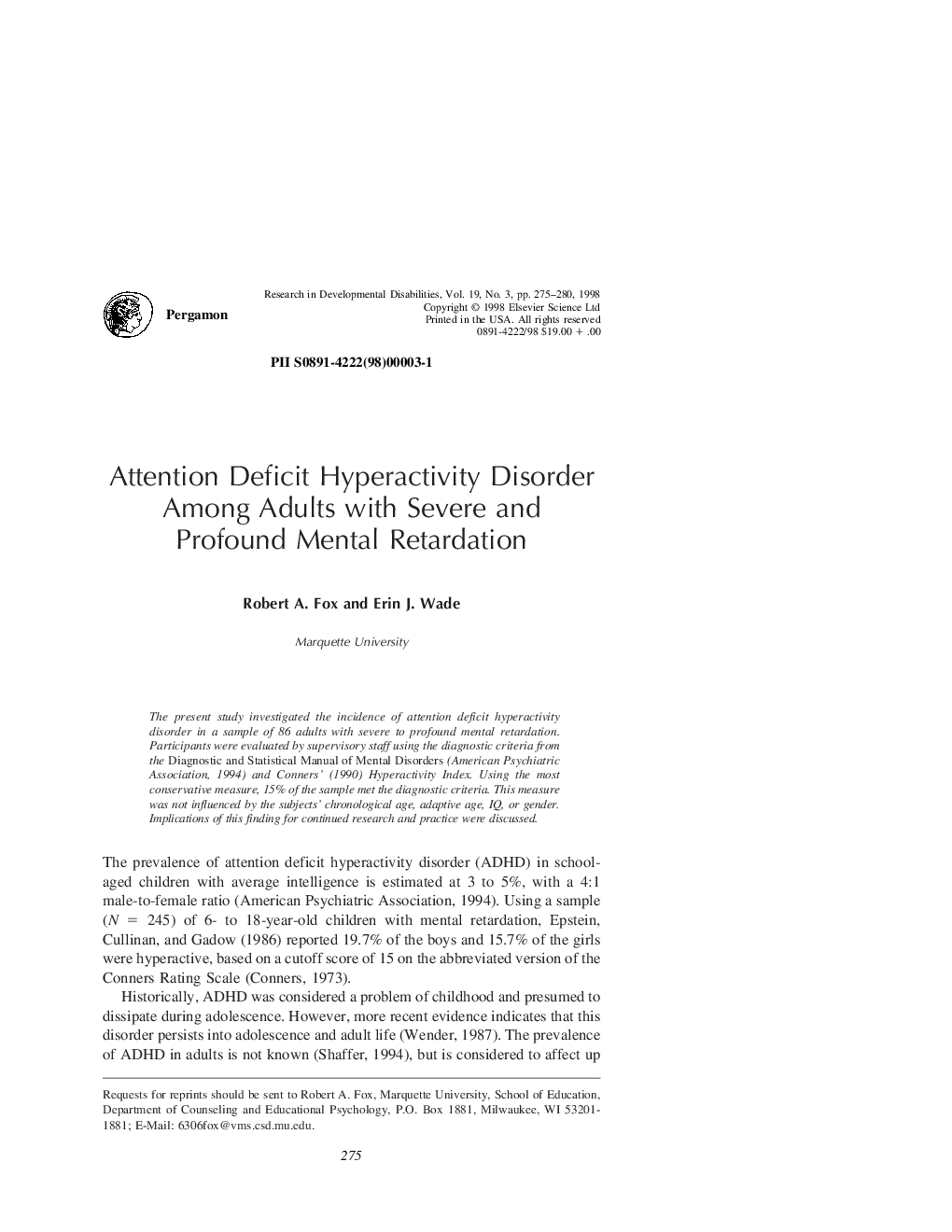| Article ID | Journal | Published Year | Pages | File Type |
|---|---|---|---|---|
| 12243292 | Research in Developmental Disabilities | 1998 | 6 Pages |
Abstract
The present study investigated the incidence of attention deficit hyperactivity disorder in a sample of 86 adults with severe to profound mental retardation. Participants were evaluated by supervisory staff using the diagnostic criteria from the Diagnostic and Statistical Manual of Mental Disorders (American Psychiatric Association, 1994) and Conners’ (1990) Hyperactivity Index. Using the most conservative measure, 15% of the sample met the diagnostic criteria. This measure was not influenced by the subjects’ chronological age, adaptive age, IQ, or gender. Implications of this finding for continued research and practice were discussed.
The prevalence of attention deficit hyperactivity disorder (ADHD) in school-aged children with average intelligence is estimated at 3 to 5%, with a 4:1 male-to-female ratio (American Psychiatric Association, 1994). Using a sample (N = 245) of 6- to 18-year-old children with mental retardation, Epstein, Cullinan, and Gadow (1986) reported 19.7% of the boys and 15.7% of the girls were hyperactive, based on a cutoff score of 15 on the abbreviated version of the Conners Rating Scale (Conners, 1973).
Historically, ADHD was considered a problem of childhood and presumed to dissipate during adolescence. However, more recent evidence indicates that this disorder persists into adolescence and adult life (Wender, 1987). The prevalence of ADHD in adults is not known (Shaffer, 1994), but is considered to affect up to 3% of the adult population (Feifel, 1996). The prevalence of ADHD in adults with mental retardation has been only indirectly studied. In a recent study by Cherry, Matson, and Paclawskyj (1997), 52.4% of younger adults and 60.7% of older adults with severe and profound mental retardation met the diagnostic criterion for Impulse Control and Miscellaneous Problems. Impulsivity is considered one of the hallmark characteristics of ADHD (Barkley, 1990).
Given that the prevalence of ADHD is considered higher in children with mental retardation than children with normal intelligence (Handen, McAuliffe, Janosky, Feldman, & Breaux, 1994; Pearson, Yaffee, Loveland, & Lewis, 1996), coupled with a growing consensus that ADHD continues into adulthood (Barkley, 1990), it seems logical that this disorder would be present in adults with mental retardation, possibly to a greater extent than adults with normal intelligence. The purpose of the present study was to investigate the incidence of ADHD in a sample of adults with mental retardation.
Subjects and procedures
The subjects were selected from a Midwestern residential facility serving 182 adults with mental retardation. The subject selection criteria for this study included being ambulatory, a diagnosis of severe to profound mental retardation, and the absence of psychotropic medications. Eighty-six subjects (61 males, 25 females) met these criteria with an average age of 41.4 years (SD = 12.4; range = 21 to 72), an average IQ of 22.2 (SD = 12.89; range = 12 to 49), and an average adaptive age of 3.3 years (SD = 1.91; range = 0.5 to 8.2).
Two instruments were used. The first instrument included the diagnostic criteria for ADHD from the Diagnostic and Statistical Manual of Mental Disorders, Fourth Edition (DSM-IV; American Psychiatric Association, 1994) and were represented by two subscales. Included were nine items representing an Inattention Scale and nine additional items representing a Hyperactivity and Impulsivity Scale. Each item is rated for the presence (scored 1) or absence (scored 0) of each criterion, resulting in scale scores ranging from 0 to 9 for inattention and ranging from 0 to 9 for hyperactivity and impulsivity, respectively. The second instrument was the Hyperactivity Index from the Conners’ Rating Scales (Conners, 1990), which includes 10 items that are rated on a four point scale (0 = not at all, 1 = just a little, 2 = pretty much, and 3 = very much). Hyperactivity Index scores could range from 0 to 30.
Ten supervisory staff members, responsible for ensuring the quality of the subjects’ daily programs and monitoring their effectiveness, were selected to rate subjects using the two instruments. All staff had a minimum of a bachelor’s degree, at least 1 year of experience working with individuals with mental retardation, and at least 6 months of experience working with the subjects they were assigned to rate. Staff were given instructions regarding administration of the study’s measures. Each rater was given a list of subjects who they were familiar with and instructed to rate the subjects relative to other adults with mental retardation at similar developmental levels. Raters completed the scales while in the presence of the subject being rated.
Related Topics
Life Sciences
Neuroscience
Behavioral Neuroscience
Authors
RobertA Fox, ErinJ Wade,
